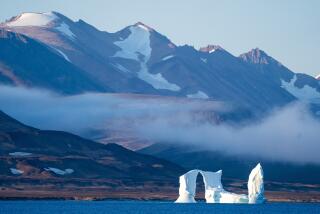Cold War Ending for Soviet Icebreakers : Tourism: Soviets offer sightseeing trips to North Pole and hope to guide Western cargo ships through the frozen Arctic.
MURMANSK, Soviet Union — Travelers wanting to witness an offbeat ending of the Cold War can book a trip to the North Pole on a Soviet nuclear-powered icebreaker.
The icebreakers, rarely seen in the West except on spy-satellite photographs, are starting sightseeing trips to the pole and may soon be guiding convoys of Western cargo ships through the Arctic wilderness.
With a sauna, indoor swimming pool, sports hall, theater and library, icebreakers such as the 52,000-horsepower Taymyr are among the most luxurious places in the Arctic.
“But life is tough on board,” Capt. Nicolay Krylov, 42, told reporters on a recent visit to the Taymyr, one of the Soviet Union’s six nuclear icebreakers.
“You work almost all the time, and crashing through the ice means constant noise and vibration,” he said.
Forty West Germans--each paying $20,500--will be the first Westerners to travel on a Soviet icebreaker to the North Pole, on a trip starting at the end of July from the northern port of Murmansk.
The Rossiya icebreaker will take about two weeks for the 1,450-mile trip to the pole, made in the constant daylight of the Arctic summer.
“This could be a regular thing,” said Vassily Loban, director of foreign relations at the Murmansk Shipping Co., which runs the icebreakers. “We’ve had inquiries from other countries, such as the United States and Canada.”
The Rossiya, with twin nuclear reactors generating 75,000 horsepower, will take a group of West German businessmen and reporters to the pole in an experiment with the Soviet Union’s policies of glasnost.
Snow-scooters and two helicopters on board will allow trips onto the icecap, Loban said.
The Murmansk Shipping Co. is also planning to start the first regular shipping service on the Arctic sea route from Europe to Japan from July--a route littered with wrecks of ships seeking the shortcut to the east.
Trips on the so-called Northeast Passage will take about 25 days, 10 days shorter than the route through the Suez Canal.
Loban said an 18,000-ton vessel of the Norilsk class, with a hardened hull, will travel the route once a month from July to October, carrying cargo for Western clients.
The Murmansk Shipping Co. is also trying to arrange for nuclear icebreakers to lead convoys of Western ships through the Northeast Passage. But so far, the Kremlin has refused.
“Technically we’re ready, but we’re awaiting a political decision by Moscow,” said Loban.
The route through the Arctic passes sensitive military installations. In the past, nuclear icebreakers could help blast routes for warships from the Pacific fleet in Vladivostok to the Northern fleet, based near Murmansk--helping to keep them away from Western surveillance.
Loban, talking to a group of reporters visiting Murmansk recently from Norway, said the Soviet Union wanted to “show off our nuclear merchant vessels, to change the world’s opinion. We have 30 years of experience and they are ecologically safe.”
Public protests in the Soviet Far East last year prevented some nuclear-powered Soviet vessels from docking.
In the reactor control room of the Taymyr, which came into service in 1989, several technicians watched a wall of dials and gauges.
One was glued to a television monitor linked to a camera scanning the reactor encased in the hull amidships a few yards away.
“Over 30 years of successful operation of the atomic icebreaker fleet,” boasts a poster in English in Krylov’s office on the Taymyr.
Krylov dismissed Western reports that the Lenin, the oldest of the icebreakers--and now being withdrawn from service--had a nuclear accident in the 1970s. It was in dock for several years “to make modernizations and change the reactor,” he said.
Norway, which is a NATO member, and the Soviet Union recently opened the first air and boat links for tourists to visit Murmansk--reflecting the easing of tensions between the neighbors.
Travelers by boat can now see and freely photograph the might of the Soviet navy, based along the Murmansk fiord.
Icebreakers can cut through sheet ice about six feet thick at a rate of 2.5 knots per hour. Ice at the pole in midsummer is usually around 16 feet thick, but fractures in the icecap allow the vessels to slice through.
The Soviet fleet has the world’s only purpose-built nuclear icebreakers. They can travel the Northeast Passage from July to November, sometimes December. Heavily insulated, covered orange lifeboats hang from the sides.
The Taymyr, 502 feet long and with a bow 1.7 inches thick, was built by Finland’s Wartsila company, but had its single nuclear reactor fitted in Leningrad.
It has a crew of about 110 men and 15 women.
Each of the crew has a separate cabin, and alcohol is restricted.
Vladimir, a radio operator, said it is possible to call home from the vessel even when it is in the Arctic, where temperatures can dip to minus 58 degrees Fahrenheit.
The corridors of the Taymyr, where the bridge is eight stories above the deck, are painted a soft yellow and have large posters of alpine or woodland scenes at every turn.
Large plastic pot plants stand in recreation rooms.
The crew works for four months followed by a four-month rest, Krylov said. Working on an icebreaker means earning several times the normal wage in the Soviet Union.
“But then there’s little to buy when you get back home,” Krylov joked.
More to Read
Sign up for The Wild
We’ll help you find the best places to hike, bike and run, as well as the perfect silent spots for meditation and yoga.
You may occasionally receive promotional content from the Los Angeles Times.






